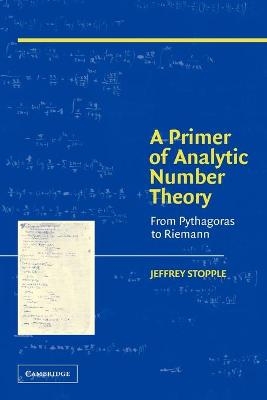
A Primer of Analytic Number Theory
From Pythagoras to Riemann
Seiten
2003
Cambridge University Press (Verlag)
978-0-521-01253-9 (ISBN)
Cambridge University Press (Verlag)
978-0-521-01253-9 (ISBN)
This 2003 undergraduate-level introduction describes those mathematical properties of prime numbers that can be deduced with the tools of calculus. The capstone of the book is a brief presentation of the Riemann zeta function and of the significance of the Riemann Hypothesis.
This 2003 undergraduate introduction to analytic number theory develops analytic skills in the course of studying ancient questions on polygonal numbers, perfect numbers and amicable pairs. The question of how the primes are distributed amongst all the integers is central in analytic number theory. This distribution is determined by the Riemann zeta function, and Riemann's work shows how it is connected to the zeroes of his function, and the significance of the Riemann Hypothesis. Starting from a traditional calculus course and assuming no complex analysis, the author develops the basic ideas of elementary number theory. The text is supplemented by series of exercises to further develop the concepts, and includes brief sketches of more advanced ideas, to present contemporary research problems at a level suitable for undergraduates. In addition to proofs, both rigorous and heuristic, the book includes extensive graphics and tables to make analytic concepts as concrete as possible.
This 2003 undergraduate introduction to analytic number theory develops analytic skills in the course of studying ancient questions on polygonal numbers, perfect numbers and amicable pairs. The question of how the primes are distributed amongst all the integers is central in analytic number theory. This distribution is determined by the Riemann zeta function, and Riemann's work shows how it is connected to the zeroes of his function, and the significance of the Riemann Hypothesis. Starting from a traditional calculus course and assuming no complex analysis, the author develops the basic ideas of elementary number theory. The text is supplemented by series of exercises to further develop the concepts, and includes brief sketches of more advanced ideas, to present contemporary research problems at a level suitable for undergraduates. In addition to proofs, both rigorous and heuristic, the book includes extensive graphics and tables to make analytic concepts as concrete as possible.
1. Sums and differences; 2. Products and divisibility; 3. Order and magnitude; 4. Counterexamples; 5. Averages; 6. Prime number theorems; 7. Series; 8. The Basel problem; 9. Euler's product; 10. The Riemann zeta function; 11. Pell's equation; 12. Elliptic curves; 13. Symmetry; 14. Explicit formula.
| Erscheint lt. Verlag | 23.6.2003 |
|---|---|
| Verlagsort | Cambridge |
| Sprache | englisch |
| Maße | 155 x 221 mm |
| Gewicht | 500 g |
| Themenwelt | Mathematik / Informatik ► Mathematik ► Arithmetik / Zahlentheorie |
| Mathematik / Informatik ► Mathematik ► Numerische Mathematik | |
| ISBN-10 | 0-521-01253-8 / 0521012538 |
| ISBN-13 | 978-0-521-01253-9 / 9780521012539 |
| Zustand | Neuware |
| Haben Sie eine Frage zum Produkt? |
Mehr entdecken
aus dem Bereich
aus dem Bereich
Sieben ausgewählte Themenstellungen
Buch | Softcover (2024)
De Gruyter Oldenbourg (Verlag)
64,95 €
unlock your imagination with the narrative of numbers
Buch | Softcover (2024)
Advantage Media Group (Verlag)
19,90 €


